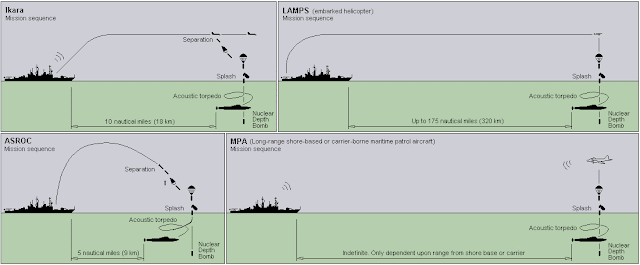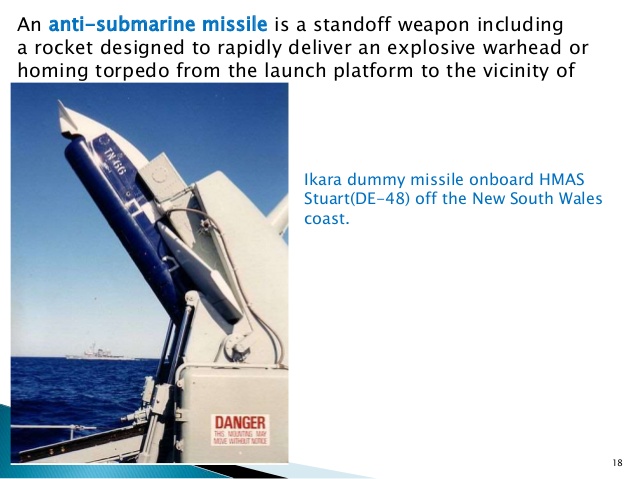L’Ikara era un missile Australiano ASW. Con lo sviluppo dell'energia nucleare, le prestazioni dei sottomarini, in particolare la velocità, sono migliorate notevolmente, così come la minaccia che rappresentano. Allo stesso tempo, anche la capacità di rilevamento del sonar a lungo raggio stava migliorando in modo significativo, ma per le navi da guerra di scorta in superficie erano disponibili solo armi a corto raggio. L'ultimo sviluppo britannico del mortaio A/S fu il mortaio Limbo era in grado di sparare in tutte le direzioni ma limitato a una portata massima di 914 metri (2.999 piedi).
Conosciuto inizialmente con il nome in codice arcobaleno Blue Duck, l'Ikara era una “arma-missile-siluro“ con somiglianze con il Malafon francese. Era diverso dal Malafon in quanto il siluro era semi-incassato nel corpo del missile piuttosto che montato a prua. L'autonomia dell’Ikara era pari a 10 miglia nautiche (19 km), il doppio di quella dell'ASROC statunitense.
L’Ikara era generalmente considerato un sistema superiore all'ASROC poiché veniva guidato accuratamente durante il volo per garantire un targeting ottimale. Un sottomarino sarebbe stato consapevole dai contatti del sonar che stava per essere attaccato e avrebbe potuto impegnarsi in cambiamenti evasivi di rotta. Nel tempo di volo di un ASROC fino a un raggio massimo di 55 secondi, un sottomarino che naviga a 25 nodi (46 km/h) potrebbe spostarsi di 700 metri (2.300 piedi) dalla sua posizione al momento del lancio, con una previsione della probabile posizione del sottomarino all’esplosione sul bersaglio del siluro. Ma durante la progettazione dell’Ikara intorno al 1960, la portata del cercatore acustico del siluro Mk.44 era limitata a 457 metri (1.499 piedi), e di conseguenza la sua probabilità di andare a segno era molto bassa. L’autonomia del cercatore acustico è stata successivamente via via migliorata.
Il bersaglio-drone Turana venne progettato e costruito in Australia come uno sviluppo del sistema d'arma anti-sommergibile Ikara. Era un drone bersaglio con telecomando che veniva lanciato dal lanciatore Ikara per l'utilizzo in esercitazioni antiaeree navali.
L’Ikara era spinto da un motore a razzo Murawa a combustibile solido a due stadi in linea sviluppato dalla Bristol Aerojet Ltd nel Regno Unito ed era guidato da un comando radio fino a raggiungere le vicinanze del sottomarino, determinato dal contatto sonar della nave, dove avrebbe prima gettato a mare la pinna ventrale posteriore e la copertura posteriore del siluro e quindi avrebbe rilasciato il siluro anti-sottomarino Mark 44 o Mark 46 da 12,7 pollici a guida acustica. Il carico utile del siluro sarebbe disceso con il paracadute mentre il missile stesso era programmato per essere rilasciato ad una certa distanza per evitare interferenze con la testa del cercatore del siluro acustico. Il siluro iniziava quindi un percorso di ricerca circolare per trovare e agganciare l’eventuale contatto sottomarino.
Sviluppo
Negli anni '50, a causa del moltiplicarsi dei sottomarini varati a causa della guerra fredda, la Marina Reale Australiana decise di dotarsi di nuovi missili antisommergibile in sostituzione degli statunitensi ASROC e dei britannici Match. Lo sviluppo della nuova arma iniziò a partire dal 1960. Le prove dell'Ikara iniziarono nel 1963, mentre nel 1965 la Government Aircraft Factory iniziò la produzione del missile nelle varianti M3, M4 e M5.
Tecnica
Il missile era dotato di una semplice cellula alata, capace di portare un siluro leggero fino a 24 km. Poteva essere impiegato da una rampa di lancio singola.
La variante M4 era la più complessa, in quanto era equipaggiata con un sistema di gestione dell'obbiettivo molto più avanzato rispetto alle più semplici varianti M3 e M5. Le quattro ali dell'ordigno potevano modificare la loro configurazione in base alle correzioni di traiettoria definite dal controllo di tiro dal quale è stato lanciato. Tali informazioni venivano inviate da un sistema di pilotaggio automatico in tempo reale alloggiato nella parte anteriore che calcolava varie informazioni come velocità bersaglio, velocità nave di lancio ecc. L'unità propulsiva era costituita da un sistema Murawa a propellente solido, indipendente dalle condizioni atmosferiche. Il missile aveva un raggio d’azione pari a quello dei sonar delle navi da cui veniva lanciato.
Impiego
Il missile fu ampiamente impiegato dalla Royal Navy e dalla Royal Australian Navy, ma attualmente risulta radiato dal servizio effettivo.
ENGLISH
The Ikara missile was an Australian ship-launched anti-submarine missile, named after an Australian Aboriginal word for "throwing stick". It launched an acoustic torpedo to a range of 10 nautical miles (19 km), allowing fast-reaction attacks against submarines at ranges that would otherwise require the launching ship to close for attack, placing itself at risk. By flying to a distant target, the engagement time was dramatically shorter than provided by short-range weapons, giving the target less time to respond.
Design and development
With the development of nuclear power, submarine performance, especially speed, improved dramatically, as did the threat they posed. Simultaneously, sonar detection capability at long range was also improving significantly, but only short-range weapons were available to surface escort warships. The final British development of the A/S mortar was the Limbo mortar, able to fire in all directions but limited to a maximum range of 914 metres (2,999 ft).
Known initially under the rainbow code name Blue Duck, the Ikara was a "Rocket-Thrown-Weapon" with similarities to the French Malafon. It differed from Malafon in that the torpedo was semi-recessed in the missile body rather than mounted in the nose. Ikara's range at 10 nautical miles (19 km) was double that of ASROC. Ikara was generally considered a superior system to ASROC as it was accurately guided during flight to ensure optimal targeting. A submarine would be aware from sonar contacts that it was about to be attacked and could engage in evasive changes of course. In ASROC's flight time to maximum range of 55 seconds, a submarine travelling at 25 knots (46 km/h) could move 700 metres (2,300 ft) from its position at launch, and a prediction would be made of the submarine's likely position at torpedo splashdown. But during the design of Ikara around 1960 the range of the acoustic seeker of the Mk.44 torpedo was limited to 457 metres (1,499 ft), and consequently its kill probability was low. The range of the acoustic seeker was later improved.
The Turana target drone was designed and built in Australia as a development of the Ikara anti-submarine weapon system. It was a target drone with remote control that was launched from the Ikara launcher for use in naval anti-aircraft target practice.
Ikara was powered by a two-stage in-line solid-fuel Murawa rocket engine developed by Bristol Aerojet Ltd in the UK and was guided by radio command link until it reached the vicinity of the submarine, determined by the ship's sonar contact, where it would first jettison the rear ventral fin and torpedo rear covering and then release its 12.7 inch Mark 44 or Mark 46 acoustically-guided anti-submarine torpedo. The torpedo payload would descend by parachute while the missile itself was programmed to splashdown some distance away to avoid interference with the acoustic torpedo's seeker head. The torpedo would then begin a circular search pattern to find and lock onto a submarine contact.
British variant differences
A variant fitted to the British Royal Navy's Leander-class frigates differed in several respects from the original Australian version designed to operate in the Pacific. The Royal Navy required changes to the frequencies used in order to enable Ikara to be used in the NATO area, where different electronic warfare conditions and international frequency agreements had to be taken into account. Neither the Australian-built analogue computer system, nor the American Bunker Ramo Corporation 133 digital computer system, used in most RAN systems, were compatible with the ADA digital battle-control computers being fitted into Royal Navy ships, and this was also changed. The UK-manufactured version of the Mark 44 torpedo also differed from the US-built version purchased by the Australians for their Ikara missiles. The British also required the missile payload to be changeable aboard ship to permit different payload combinations to be used, including a nuclear depth bomb (NDB) option, and this, together with the different internal ship layouts required further changes to the missile, storage and handling arrangements. The Australian practice was to combine the missile and payload at a shore-based ordnance facility and issuing the complete unit to a ship; repair or maintenance was only possible ashore. In the British ships, the changes made enabled a faulty torpedo on a missile in working order to be replaced, increasing the flexibility of use of very limited stocks aboard; especially on lengthy deployments around the globe, as was more common with British ships than their Australian counterparts. The facility to change a torpedo payload aboard ship also permitted a change from a conventional torpedo to a WE.177A NDB, a facility for a nuclear option that was not needed on ships fitted with the Australian variant of Ikara. The British launcher also differed, covered by a zareba (breakwater) when not in use to prevent icing in northern waters, and extremely accurate in training in bearing. It was also notoriously noisy.
Ikara fitted ships
Ikara was fitted to all of the Royal Australian Navy (RAN) River-class frigates/destroyer escorts and Perth-class guided-missile destroyers. There were three main variants of the system fitted to RAN ships; F1, F2, and F3. The F1 system, using an analogue computer, a single launcher and without a data link, was fitted to HMA Ships Stuart and Derwent only. The F3 system, with a digital computer, digital display, single launcher and a digital data link, was fitted to the other four River class ships. HMAS Stuart and Derwent were fitted with F3/0 systems during Half-life refits during the 1980s. The F2 system, using a digital computer, digital display, two launchers and with a digital data link, was fitted to the three Perth-class destroyers. The digital computer used by the RAN was the AN/UYK-1 NTDS (Naval Tactical Data System) (Bunker Ramo 133). The Ikara missile was withdrawn from service by the RAN in 1991.
Ikara was also operated by the Brazilian Navy, Royal Navy, and Royal New Zealand Navy. It was phased out in the early 1990s due to the obsolescence of the Mk 44 torpedo and inability to carry the newer and heavier Mk 46 or Stingray. The British purchased Ikara to fit to the two new CVA-01 aircraft carriers planned (and later cancelled) in the 1960s, and their escorts, the Type 82 destroyers, of which only one, HMS Bristol was built. With the cancellation of the remaining escorts, the British were left with purchased Ikara missiles in storage, and opted to fit them into eight existing Batch 1 Leander-class frigates in need of modernisation: HM Ships Ajax, Arethusa, Aurora, Dido, Euryalus, Galatea, Leander and Naiad.
Operators
Former operators:
- Australia - Royal Australian Navy
- Brazil - Brazilian Navy
- Chile - Chilean Navy
- New Zealand - Royal New Zealand Navy
- United Kingdom - Royal Navy.
(Web, Google, Wikipedia, You Tube)

























Nessun commento:
Posta un commento
Nota. Solo i membri di questo blog possono postare un commento.